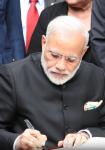Ten years ago, Tom Clancy, master of the peculiarly American art of techno-novels, wrote a book called Executive Orders, in which Iran, China and India collude against the United States. It was rather a good book, even if at 1200-odd pages, a bit too fat.
Now Arvind Virmani (Director, Indian Council for Research on International Economic Relations) has sketched out a different scenario. In a recent working paper* he concludes "that the current unipolar world will be transformed into a bipolar world during the first quarter of this century, and into a tri-polar one (China, USA, India) during the second quarter of the century." Europe will fade away.
He also recommends "the formation of an Asian Economic Community, patterned on the European Economic Community, with China, India and Japan at its core and including other countries of Asia."
The paper is actually an extension of another paper he had written a whit earlier. In that he had analysed the economic basis of national power and given projections for the global economy and national power potential up to 2035. Here he has revised and extended those projections to 2050.
Virmani depends on two assumptions for what some may regard as a rather optimistic conclusion about India, China and the US forming a trinity. One, that India and China will not be rivals; and two that India and the US will co-operate as closely and deeply as perhaps the US and the UK do at present.
It is worth considering, however, whether the two are not mutually exclusive. Historically, in a three-power situation, two have always colluded against the third.
The partners, as we saw in George Orwell's 1984, may change but the fact remains: triangular collaboration is inherently unstable. Besides, three-person games, I need hardly point out to Virmani, are the only ones in game theory without stable solutions.
Be that as it may, the process Virmani outlines is absorbing. Thus, he says, in the next decade China's economy will become larger than of the US, a projection first made by Larry Summers in 1993.
"Its power potential will therefore equal that of the United States sometime during the second quarter of this century." But well before that the US would have lost its monopoly of world power as China challenges it.
Then, "in parallel, India's economy will overtake Japan's within five years to become the third largest in the world. Its incremental impact on the global economy will exceed that of Japan within 15 years. The Indian economy will equal the US economy in size by 2040. The world will, therefore, become tri-polar by the middle of the century."
Naturally, "India will be the weakest pole for most of this century." Here Virmani raises but does not explore the most crucial question of all: China's attitude towards India.
At present, China despises India as a weakling. If relations between it and India have to improve, there will have to be a fundamental change in China's attitude. Virmani's paper would have been richer if he had discussed this aspect in some detail.
He also goes a bit awry when he says that "the US and India . . . have no conflicts of interest." What about Pakistan, then? As he himself says, "for the next decade or so US foreign policy will be driven by its traumatic experience of 9/11."
This makes Pakistan an important concern of US foreign policy. With Iran going the way it is, Pakistan's importance is likely to grow for the US, not diminish.
It would also have been helpful if, while discussing the likely scenario over the next half century, Virmani had given a specific, explicit and detailed place to the politics of energy, which is likely to be the single most important driver of foreign policy. Increasingly, energy is going to be the parameter around which national interests are defined.
* A Tripolar Century: USA, China and India, ICRIER WP No 160, www.icrier.org






